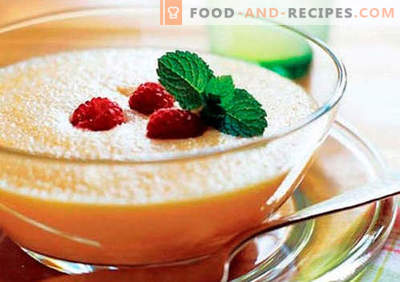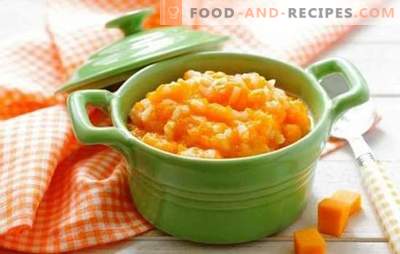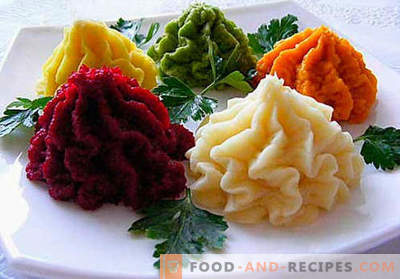
From four to five months, the baby begins to experience a deficiency in certain nutrients that he is no longer able to get with mother's milk. In addition, his digestive system at this age is ready to “take” additional supplements. Therefore, pediatricians, starting from 4-6 months, recommend mothers to introduce monocomponent vegetable and fruit purees into the baby’s diet. For the first acquaintance with vegetables crumbs ideal mashed pumpkin, cooked at home. It is rich in trace elements, especially carotene, nutritious and contains fiber, which helps regulate digestion. If your baby is not allergic to pumpkin, then be sure to give him a healthy mash at least three times a week. He will surely enjoy his “sunny” color and pleasantly-sweet taste.
Pumpkin puree for children - general principles and methods of preparation
The main goal of children's cooking is to make food safe, well digestible, as healthy as possible and, of course, delicious, so that the little tot will not turn its nose from it. In principle, complex recipes for pumpkin puree for children do not exist. It all comes down to one thing - to heat the vegetable and chop it with a blender or a regular fork. As an additional ingredient, in the absence of allergy, green apple, bananas, carrots, potatoes, as well as other vegetables and fruits easily tolerated by your child can be added to the puree.
It is very important to follow the basic rules of hygiene. The baby needs to select their own tableware (plate, spoon, mug), and for making mashed potatoes, parents should use individual dishes. By the way, the devices for making mashed potatoes should be first filled with boiling water, especially for children up to the first year, whose digestive system is most susceptible to various adverse factors. As for refined sugar, here the opinions of moms are divided: someone adds it to pumpkin mash in small quantities, and someone completely refuses it. Adding or not adding sugar to baby food is a purely individual matter and depends primarily on the physiological characteristics of the child. However, pediatricians recommend limiting sucrose intake to young children to the maximum, especially before the first year of life. In extreme cases, you can add natural fructose or sweet fresh fruit to puree.
So, the pumpkin for softening can be prepared in the following ways: bake in the oven (microwave), cook for a couple or by traditional cooking in a saucepan. The most gentle is the method of heat treatment of steamed vegetables. As a rule, this approach allows you to avoid the "leakage" of useful elements from the pumpkin during cooking.
Pumpkin Puree for Kids - Food Preparation
For baby puree, it is better to choose young, small pumpkin fruits (weighing up to 3-5 kg), since they are less fibrous, very juicy and have a more pronounced pleasantly sweetish taste. In addition, the skin is removed from those much easier than with large fruits. If the “shell” is still too hardened during long-term storage - do not worry. After heat treatment, it quickly and easily get off the pulp. Pumpkin seeds must be removed (it is convenient to do this with a usual tablespoon), since they are not suitable for baby food.
Pumpkin Puree for Kids - Best Recipes
Recipe 1: Pumpkin Puree for babies (under 1 year)
Absolutely simple in the preparation of mashed potatoes, which is designed for children aged 4 to 12 months. And the dill included in the puree will help the baby to strengthen the digestive system and rid it of the tummy tuck.
Ingredients:
- pumpkin pulp
- whispered dill (not stalks)
- some mother's milk (or mixture) for dilution
Method of preparation:
Boil some pumpkins in a pan, a double boiler or bake the pieces in the oven. Then whisk in a blender with a sprig of dill. Shuffle until smooth. If the puree is too thick, it should be diluted with a few drops of the mixture or breast milk. You can also dilute the vegetable broth or ordinary boiled water.
Recipe 2: Pumpkin Puree with Green Apple
Why precisely with green? Because it is practically non-allergenic and contains more vitamin C. In the process of making mashed potatoes, the apple must be crushed thoroughly so that no flakes or pieces are left. The proportion of ingredients may vary depending on the mood and preferences of the child (usually 50x50).
Ingredients:
- pumpkin
- green apple
Method of preparation:
Pumpkin is thermally processed in the usual way so that it becomes soft, remove the skin, and turn the flesh into mashed potatoes. Apple must be cleaned from the skin and seeds, grind it into puree separately. Mix together with the juice with pumpkin puree. For a change, an apple can be replaced with a banana.
Recipe 3: Pumpkin puree for the winter (from 6 months)
To feed the baby in the summer with homemade vegetable puree is easy. But what if the yard is winter and the vegetables have outlived theirs? Naturally, stock them for the future using the freezer. You can do a little differently - immediately prepare your baby pumpkin puree for the winter.
Ingredients:
- one medium pumpkin (ripe)
- sugar (get exactly brown) - about a glass
- one liter of water
- 200 gr. cranberries
- pinch of cloves for taste
Method of preparation:
Pumpkin cleaned of seeds and fibers, cutting it in half. Cut into small pieces. Mix the water with sugar in an enamel pot and lay the pumpkin pieces there too. We put on the stove and bring, constantly stirring, to a boil. Squeeze the juice from the cranberries and add it to the pumpkin. Cook for about 20 minutes, 5 minutes before readiness we throw a couple of clove kernels. Next, drain the water, and solid ingredients thoroughly grind in a blender. While the mash cools down, boil the jars, lids, dry them in a hot oven, then lay the mash over the jars and cork. Tasty and healthy pumpkin puree for the winter is ready!
Pumpkin Puree - Useful Tips
Every mother should remember: baby food should be introduced with extreme caution. First, it is connected with the work of the gastrointestinal tract in infants - saliva is practically not excreted, and gastric juice is not produced. That is why lure is introduced gradually, starting with easily digestible monocomponent vegetables. Secondly, on any component, even the most innocuous at first glance, an allergic reaction can develop in the toddler. As much as mom would not want her child to quickly taste all sorts of goodies, no need to hurry. Start small, with half a teaspoon, and if all goes well, gradually increase the amount of complementary foods. In addition to pumpkin pulp, many children enjoy freshly squeezed pumpkin juice, which is rich in vitamins and amino acids. And if the crumbs are constantly tormented by swelling or constipation, as well as inflammatory diseases of the urinary sphere, then the use of such juice will become a real “lifeline” for them. It will help improve health and prevent relapses.
In recent years there has been much controversy about the dangers of salt for young children. In fact, slightly salted puree does not harm the growing organism. But try not to overdo it, because too much of its concentration can cause a serious blow to the health of the crumbs. You do not need to add salt to sweet pumpkin puree, but if the pumpkin is diluted with mashed potatoes or, for example, cauliflower, a pinch here does not hurt. However, do not rush. It is likely that your baby will be happy to eat vegetable puree without adding salt.























